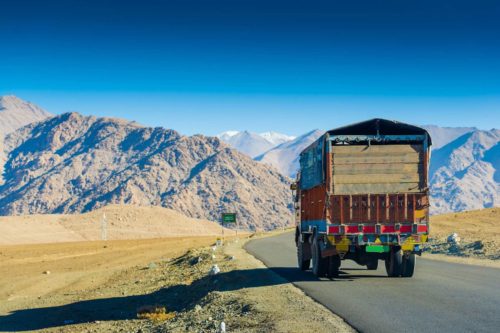Leh in Ladakh the far Norther part of India

Moving India’s Goods without Emissions
Rising demand for goods and services in India has supported the country’s rapid economic growth over the past decade. However, it has also driven growth in freight activity, leading to increased oil consumption and carbon emissions. Electrifying trucks and delivery vehicles in India could alleviate this, saving $97 billion in annual oil imports and 7 gigatons of carbon emissions between now and 2050, one of the largest decarbonization opportunities in the transportation sector.
Fortunately, a set of supportive conditions and policies are providing tailwinds to the replacement of diesel trucks with electric trucks in the country.
- The government of India has made vehicle electrification a signature policy priority, with $1.4 billion allocated to purchase incentives for electric vehicles (EVs) and $2.4 billion approved for production-linked incentives for batteries.
- Improving air quality in Indian cities is a top government priority. Outdoor air pollution caused over 1 million deaths in 2019 in India, and in New Delhi, four out of ten children suffer from respiratory ailments.
- India’s National Mission on Transformative Mobility and Battery Storage aims to make India a world leader in electric mobility solutions and manufacturing hub for expert competitive batteries.
But much of the focus of the EV push in India has gone toward passenger vehicles, overlooking the massive opportunity for energy and emissions savings hiding in plain sight in road freight vehicles.

Rapid Growth in Demand
Rising demand for goods and services in India has supported the country’s rapid economic growth over the past decade. Currently, commercial activities in India generate 4.6 billion tons of freight annually, leading to over 3 trillion ton-km of goods movement. With rising income levels, higher exports, a rapidly growing e-commerce sector, and a growing retail sales market, the demand for goods is also expected to increase at 7 percent compound annual growth rate (CAGR). This would lead to total goods transport demand of 16 trillion ton-km in 2050. This activity will spur vehicular travel across freight modes, especially in road freight transport, leading to nearly 3 trillion vehicle kilometers traveled on Indian roads by freight vehicles in 2050.
This growth in demand presents an opportunity for India to pursue an alternate technology pathway and rapidly deploy zero-emissions trucks. But urgent action is required to lay the groundwork for the zero-emissions trucking pathway. Every diesel truck in India emits 1,300 tons of CO2 over its lifetime. With sales growing at 10 percent CAGR (based on sales between 2014 and 2019), the cost of inaction grows greater each year.
First Mover: Final-Mile Delivery
Urban delivery, also known as the “final mile” commonly accounts for more than 50 percent of the total logistics cost and disproportionately contributes to air pollution and carbon emissions. Given the exponential growth in e-commerce, efficiency in final-mile distribution will be critical to reducing costs and emissions.
Electric delivery vehicles for final-mile distribution present an opportunity to reduce both operational costs and vehicular emissions associated with increasing e-commerce activities, the benefits of which can be passed on to the consumers and society. And the economics of urban delivery increasingly favor electric models. For example, on a total cost of ownership basis, electric two wheelers are currently at cost parity with internal combustion alternatives at 2 INR/km and electric three wheelers will reach the same milestone next year at 2.5 INR/km.
RMI has partnered with the Delhi Government and 36 private companies to electrify final-mile delivery in Delhi. The program, known as Deliver Electric Delhi aims to demonstrate and quantify the savings associated with electric delivery vehicles with the eventual goal of transitioning 100 percent of final mile deliveries to electric at a national scale.
Fast Follower: Medium- and Heavy-Duty Trucks
The global technology for medium- and heavy-duty electric trucks is improving and will become increasingly cheaper, but plans for deployment inside India are not advancing quickly enough to ensure the transition will happen on its own in the time frame required to ensure the decarbonization of the sector. Achieving the needed speed and scale will require a dedicated policy push to get technologically competitive vehicles on the road.
No heavy-duty electric trucks are currently plying Indian roads, and in order for the benefits of the technology to be fully appreciated, a need exists to establish India’s first electric trucking corridor. Over 50 percent of all freight transport in India is concentrated on seven corridors. This highly concentrated pattern of freight movement makes an ideal environment for technical demonstrations, with successful deployments proving widespread applicability. As a first step, RMI is initiating conversations with the state governments and industry players to identify a promising corridor and outline the framework for the corridor.
Laying an Example for Others to Follow
The impact of India transitioning to zero-emissions trucks would be globally significant from an emissions perspective but would also create a powerful example for other developing nations.
Today, zero-emissions trucking is largely being pursued in North America and the EU. However, developing nations produce and ship many of the goods ultimately consumed globally. As a result, nearly all of the forecasted growth in trucking demand is occurring in developing economies. India can show a pathway of beneficial electrification for trucking and freight transport that improves air quality, reduces costs, and enhances competitiveness though reduced embodied carbon of exports. If other countries follow suit, it could transform the emissions and pollution trajectories across many emerging economies.